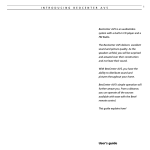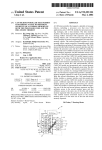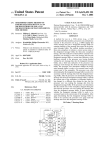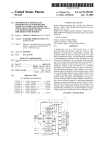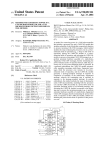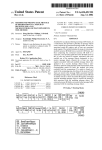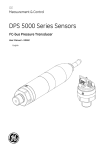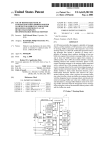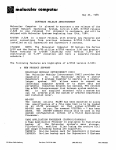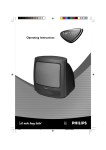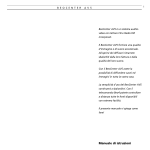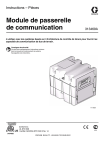Download Transmit pre-arbitration scheme for a can device and a can device
Transcript
US006510479B1 (12) United States Patent (10) Patent N0.: (45) Date of Patent: Ha0 US 6,510,479 B1 Jan. 21, 2003 Primary Examiner—Sumati LefkoWitZ Assistant Examiner—Christopher E. Lee (54) TRANSMIT PRE-ARBITRATION SCHEME FOR A CAN DEVICE AND A CAN DEVICE THAT IMPLEMENTS THIS SCHEME (57) ABSTRACT (75) Inventor: Hong Bin Hao, San Jose, CA (US) In a CAN device, e.g., a CAN microcontroller, that supports a plurality of message objects, a method that includes (73) Assignee: Koninklijke Philips Electronics N.V., Eindhoven (NL) (*) Notice: concurrently staging tWo or more transmit messages asso ciated With respective ones of tWo or more enabled transmit Subject to any disclaimer, the term of this patent is extended or adjusted under 35 message objects for attempted transmission over a CAN bus coupled to the CAN device, and performing a pre-arbitration USC 154(b) by 255 days. process to determine Which of the tWo or more concurrently staged transmit messages has priority. The message deter (21) Appl. No.: 09/630,642 (22) Filed: Aug. 1, 2000 mined to have priority is deemed a Winning message and the message object associated With the Winning message is deemed a Winning message object. In a presently preferred Related US. Application Data (60) embodiment, the pre-arbitration process is a selected one of at least tWo pre-arbitration schemes, including a ?rst pre Provisional application No. 60/154,022, ?led on Sep. 15, 1999. (51) Int. Cl.7 .............................................. .. G06F 13/14 (52) (58) US. Cl. ...................... .. 710/240; 710/116; 710/305 Field of Search ....................... .. 709/229; 713/502; arbitration scheme Whereby priority is determined according to a CAN bus arbitration priority scheme established by the governing CAN protocol, and a second pre-arbitration scheme Whereby priority is determined by selecting the 370/300; 700/1, 23; 710/240, 116, 305 (56) transmit message associated With the highest-numbered (or, alternatively, lowest-numbered) message object as the Win References Cited ning message. In the event that more than one of the tWo or U.S. PATENT DOCUMENTS 5,179,708 A 5,323,385 A 5’506’966 A * more concurrently staged transmit messages are determined 1/1993 Gyllstfom et a1~ ~~~~~~~~ ~~ 395/725 6/1994 Jurewlcz et a1‘ " 370/300 to have the same priority, the transmit message associated With the highest-numbered message object is designated as 4/1996 Ban """""" " the Winnin messa e The method further includes attem t ' 6,304,908 B1 * 10/2001 . 395/250 Kalajan .. 709/229 . _ 6,357,014 B1 * 3/2002 Correia ..................... .. 713/502 FOREIGN PATENT DOCUMENTS . g _ g '_ . _ . p mg 1? trénsmlt the W1_nn1ng message Over the CAN bus~ If the Wmmng message is not granted access to the CAN bus, the pre-arbitration priority determination process is EP WO 0378195 A2 WO8806317 7/1990 ........... .. G06F/5/06 8/1988 ........... .. G06F/9/46 repeated. * cited by examiner 35 Claims, 7 Drawing Sheets f l- _ _ ' _ _ ' _ ' - ' T - ' _ - - - - _ - _ E ‘ _ _ _ ' _ _ _ ' - _ - - _ - - _ - - _ - _ _ - 20 - - - --' : 24x 32K BYTES : 22 x43 DAT 26M 1024 BYTES DATA RAM ‘V EXTERNAL I I XRAM 2 BUS f 27 DATABUS MEMORY ‘ MMR BUS ‘7"’. INTERFACE ‘r- _________ H <1; DMA ; ENGINE E 30 40 die | | 1 I I MMRS l 51 4+ ( V . i : H : r‘ H" UARTU I‘ 4+ 36 s2 : 5 41 x28 ADDRESS/ : : SF“ Bus ROM/EPHOM l 5 T CORE DATA Bus PROGRAM 2 > BUSXA CPUM CORE M [ E - 34 5E: : l : _ : 38 I SP| 0 TIMERO T’ :53 , ~ TIMER1 <1— 1 ' A54 : =3 = TIMERZ <:— 0 <»—j I I | l RX—l——I-> I 1 I 205 CAN/DLL ‘' | ‘ ">1 Tx<-l-_-____-42_‘1_f CORE ‘IL ' i — _________ n" \‘77 <~:——--> PORTS 0-3 ‘T__ = WATCHDOG I TIM'EH 55 E = ‘z _________ -fitf. ____________________ _.N _ j ; _ 5 U.S. Patent Jan. 21, 2003 Sheet 3 0f 7 US 6,510,479 B1 MMRs MMR name I R/W? I Reset I_Aeeess lAddressDtfset [Description Message Object Registers (n = 0 - 31) MnMIDH MnMlDL RAN RAN x....x00b xxxxh Word only Word only MnMSKH R/W x....x000b Word only DDDn4n3ngn1ng0i0DhM4h) MessagenMask High MnMSKL R/W xxxxh 0D0n4n3n2n1ngDt1Db (n6h) Message n Mask Low MnCTL R/W O0000xxxh Byte/Word 000n4n3n2n1ngl0UUh(n8h) MessagenControi MTiBLH MnBSZ R/W R/W XXXXh Word only DDDDDxxxh Byte/Word UUUR4R3R2H1 not 01 0b (nAh) Message n Butter Location 000n4n3n2n1n0ii0DhlnCh) MessagenButter Size MnFCR R/W Otixxxxxxh Byte/Word DDDrungngnrngiiiDhMEh) MessagenFragmentation Count CIC Registers MCPLL R/C ODDOh Byte/Word 224h Message Complete Low MCPLH CANINTFLG MClR R/C R/C R0 0000h 0000h 000Oh Byte/Word Byte/Word Byte/Word 226h 228h 229h Message Complete High CAN Interrupt Flag Register Message Complete Into Reg. MEIR FESTR FEENR RO R/C R/W DODOh DODDh DDOOh Byte/Word Byte/Word Byte/Word 22Ah 22Ch 22Eh Message Error into Register Frame Error Status Register Frame Error Enable Register SCP/SPl Con?guration SCP/SPI Data SCP/SPI Control and Status Word only DU0n4n3n2n1ng00DDh(n0h) MessagenMatch ID High DDDn4n3n2n1ng00i0h(n2h) MessagenMatohlDLow SPiCFG SPI DATA R/W R/W DDDDh 00h SCP/SPI Registers Byte/Word 26Dh Byte/Word 262h SPICS R/W 00h Byte/Word 263h CANCMR CANSTR CANBTR W R/D R/W 0th 00h 00h 008 Registers Byte/Word 2Tl1h Byte/Word 27th Byte/Word 2T2h TXERC RXERC R/W R/W* R/W* 00h 00h 00h Byte/Word Byte/Word Byte/Word EWLR ECCR R/W R0 96h 0000h Byte/Word Byte/Word ALCR RTXDTM GCTL R0 W0 R/W 0000h DDDDh Ulitidh Byte/Word Byte/Word Byte/Word XRAMB R/W FEh MBXSR MlFBTRL MIFBTRH R/W R/W FEh EFh R/W EFh 2T3h 274h 275h 276h 2T8h 27Ah 27Ch 27Eh MIF Registers Byte/Word 290h Byte/Word 29th Byte/Word 292h ?ne/Word 293h CAN Command Register CAN Status Register CAN Bus Timing Reg. (low) CAN Bus Timing Reg. (high) Tx Error Counter Rx Error Counter Error Warning Limit Register Error Code Capture Register Arbitration Lost Capture Reg. RTX Data Test Mode Global Control Byte XRAM Base Address Msg. Butt/XRAM Beg. Reg. MIF Bus Timing Reg. Low MIF Bus Timim Reg High Legend: R/W = Read it Write, R0 = Read Only, WD = Wri teOnly, R/C=Read&Clear, W*=Writah|eoniy during CAN Reset mode, x = undefined atter reset. 4 U.S. Patent Jan. 21, 2003 Sheet 4 0f 7 US 6,510,479 B1 Data Memory Segment 0 OOFFFFh _|_|_|_u_l_u 0tt—Chip 4K Bytes MMR Space HTITHT MMR Base Address Off-Chip 512 BytesT XRAMI‘I'I'ITI'FI' XRAM Base Address Ott-Chip 0003FFh _J_I_L_L.LI_LJ Ott-Chip Data Memory (Scratch Pad) ITI'I'ITIT OOOOOOh MMR Space Offset FFFh ——> Ottset tFFh —-> 512 Bytes Object Registers |———— <—— O?set OOOh U.S. Patent Jan. 21, 2003 Sheet 5 0f 7 US 6,510,479 B1 Segment xy in Data Memory Space xyFFFFh __________I object HT Object n Message Buffer 323 316 315 30 XRAM 512 Bytes a23 a16 at5 a8 a7 at) t— <— MBXSRtYzU] XRAMB[7:1]0 000 I xyOOOOh Segment xy in Data Memory Space xyFFFFh __________l 2123 2116 605 <—— MBXSR[7:0] a0 MnBLR Obiect HT Object n Message Butter XRAM 512 Bytes Butter size | XRAM a23 a16 a15 a8 a7 [_____<_ MBXSRUzO] XRAMB[7:1]0" 00h l xy0000h at] U.S. Patent Jan. 21,2003 Sheet 6 of7 US 6,510,479 B1 Object n Match ID Field (MnMlDH and MnMlDL) Mid28~Mid18 Mid17—Mid10 Mid9-Mid2 Mldl MidO MIDE Object n Mask Field (MnMSKH and MnMSKL) MSk28 — MSk18 Msk17 — MSklO MSk9 — MSk2 Mskl MskO Screener ID Field (assembled from incoming bit-stream) CAN |D.28 — CAN lD.18 Data Byte 1 [7:0] Data Byte 2 [7:0] x IDE MidO MIDE x FIG. 9 Object n Match ID Field (MnMlDH and MnMIDL) Mid28-Mid18 Mid17—Mid10 Mid9-Mid2 Midi Object n Mask Field (MnMSKH and MnMSKL) Msk28 — Mskl8 MSk17 — MsklO MSk9 — MSk2 MSk1 MSkO Screener ID Field (assembled from incoming bit-stream) CAN ID.28 — CAN |D.0 FIG. 10 IDE U.S. Patent Jan. 21, 2003 Sheet 7 0f 7 US 6,510,479 B1 Been ttt‘étét‘é'tN‘éF Data Byte 2 Data Byte 3 ADDRESS Data Byte DLC Data Byte 2 (next) Data Byte 3 (next) FIG. 11 Frame'mo Data Byte 1 Data Byte 2 Data Byte DLC Framelnto (next) Data Byte 1 (next) Data Byte 2 (next) FIG. 12 DIRECTION OF INCREASING ADDRESS US 6,510,479 B1 1 2 TRANSMIT PRE-ARBITRATION SCHEME FOR A CAN DEVICE AND A CAN DEVICE THAT IMPLEMENTS THIS SCHEME is believed that the XA-C3 is the ?rst chip that features hardWare CAL support. This application claims the full bene?t and priority of The XA-C3 is a CMOS 16-bit CAL/CAN 2.0B micro 5 US. Provisional Application Ser. No. 60/154,022, ?led on controller that incorporates a number of different inventions, including the present invention. These inventions include Sep. 15, 1999, the disclosure of Which is fully incorporated novel techniques and hardWare for ?ltering, buffering, handling, and processing CAL/CAN messages, including herein for all purposes. the automatic assembly of multi-frame fragmented mes sages With minimal CPU intervention, as Well as for man BACKGROUND OF THE INVENTION aging the storage and retrieval of the message data, and the memory resources utiliZed therefor. The present invention relates generally to the ?eld of data communications, and more particularly, to the ?eld of serial communications bus controllers and microcontrollers that incorporate the same. CAN (Control Area Network) is an industry-standard, The present invention relates to a CAN microcontroller that supports a plurality (e.g., 32) of message objects, each one of Which is assigned a respective message buffer Within 15 automotive and industrial control applications, as Well as in the user (programmer) by simple programming of memory mapped registers provided for this purpose. The message medical devices, avionics, office automation equipment, consumer appliances, and many other products and appli buffers are used to store incoming (receive) messages and to cations. CAN controllers are currently available either as stand-alone devices adapted to interface With a microcon troller or as circuitry integrated into or modules embedded in a microcontroller chip. Since 1986, CAN users (softWare programmers) have developed numerous high-level CAN Application Layers (CALs) Which eXtend the capabilities of an on-chip and/or off-chip portion of the overall data memory space of the CAN microcontroller. The location and siZe of each of the message buffers can be recon?gured by tWo-Wire serial communications bus that is Widely used in 25 the CAN While employing the CAN physical layer and the CAN frame format, and adhering to the CAN speci?cation. CALs have heretofore been implemented primarily in softWare, With very little hardWare CAL support. Consequently, CALs have heretofore required a great deal of stage outgoing (transmit) messages. With the XA-C3 micro controller that constitutes a presently preferred implemen tation of the present invention, Direct Memory Access (DMA) is employed to enable the XA-C3 CAN module to directly access any of the 32 message buffers Without interrupting the processor core. This message storage scheme provides a great deal of ?exibility to the user, as the user is free to use as much or as little message storage area host CPU intervention, thereby increasing the processing as an application requires, and is also free to position the message buffers Wherever it is most convenient. This message storage scheme is a key element of the overhead and diminishing the performance of the host CPU. unique “message management” capabilities of the XA-C3 CAN microcontroller, as this scheme enables the XA-C3 Thus, there is a need in the art for a CAN hardWare implementation of CAL functions normally implemented in 35 CAN/CAL module to concurrently assemble many (up to softWare in order to offload these tasks from the host CPU 32) incoming, fragmented messages of varying lengths, and, to the CAN hardWare, thereby enabling a great savings in at the same time, stage multiple outgoing messages for transmission. Since incoming message assembly is handled entirely in hardWare, the processor is free to perform other tasks, typically until a complete message is received and host CPU processing resources and a commensurate improvement in host CPU performance. One of the most demanding and CPU resource-intensive CAL functions is message management, Which entails the handling, storage, ready for processing. and processing of incoming CAL/CAN messages received SUMMARY OF THE INVENTION over the CAN serial communications bus and/or outgoing CAL/CAN messages transmitted over the CAN serial com munications bus. CAL protocols, such as DeviceNet, The present invention encompasses, in one of its aspects, 45 CANopen, and OSEK, deliver long messages distributed a method implemented in a CAN device, e.g., a CAN microcontroller, that supports a plurality of message objects, over many CAN frames, Which methodology is sometimes referred to as “fragmented” or “segmented” messaging. The process of assembling such fragmented, multi-frame mes sages has heretofore required a great deal of host CPU intervention. In particular, CAL softWare running on the host that includes concurrently staging tWo or more transmit messages associated With respective ones of tWo or more enabled transmit message objects for attempted transmission over a CAN bus coupled to the CAN device, and performing a pre-arbitration process to determine Which of the tWo or CPU actively monitors and manages the buffering and processing of the message data, in order to facilitate the more concurrently staged transmit messages has priority. assembly of the message fragments or segments into com Winning message and the message object associated With the Winning message is deemed a Winning message object. In a presently preferred embodiment, the pre-arbitration plete messages. Based on the above and foregoing, it can be appreciated that there presently eXists a need in the art for a hardWare The message determined to have priority is deemed a 55 process is a selected one of at least tWo pre-arbitration implementation of CAL functions normally implemented in schemes, including a ?rst pre-arbitration scheme Whereby softWare in order to offload these tasks from the host CPU, priority is determined according to a CAN bus arbitration thereby enabling a great savings in host CPU processing priority scheme established by the governing CAN protocol, resources and a commensurate improvement in host CPU and a second pre-arbitration scheme Whereby priority is determined by selecting the transmit message associated performance. The assignee of the present invention has recently devel oped a neW microcontroller product, designated “XA-C3”, that ful?lls this need in the art. The XA-C3 is the neWest member of the Philips XA (extended Architecture) family of high performance 16-bit single-chip microcontrollers. It With the highest-numbered (or, alternatively, loWest numbered) message object as the Winning message. In the 65 event that more than one of the tWo or more concurrently staged transmit messages are determined to have the same priority, the transmit message associated With the highest US 6,510,479 B1 4 3 numbered message object is designated as the Winning message. The method further includes attempting to transmit the Winning message over the CAN bus. If the Winning XA-C3 microcontroller; FIG. 4 is a table listing all of the Memory Mapped message is not granted access to the CAN bus, the pre Registers (MMRs) provided by the XA-C3 microcontroller; FIG. 3 is a high-level, functional block diagram of the arbitration priority determination process is repeated. FIG. 5 is a diagram illustrating the mapping of the overall data memory space of the XA-C3 microcontroller; FIG. 6 is a diagram illustrating the MMR space contained Within the overall data memory space of the XA-C3 micro In another of its aspects, the present invention encom passes a CAN device, e.g., a CAN microcontroller, that implements the above-described method of the present invention. In a presently preferred embodiment, the CAN microcontroller includes a plurality of message buffers asso ciated With respective ones of the message objects, a pro cessor core for running CAN applications, a CAN/CAL module for processing transmit and receive messages, at 10 controller; a DMA engine that enables the CAN/CAL module to directly access the message buffers Without interrupting the FIG. 7 is a diagram illustrating formation of the base address of the on-chip XRAM of the XA-C3 microcontroller, With an object n message buffer mapped into off-chip data memory; FIG. 8 is a diagram illustrating formation of the base address of the on-chip XRAM of the XA-C3 microcontroller, With an object n message buffer mapped processor core. into the on-chip XRAM; least one object-speci?c control register associated With each message object, at least one global control register, and 15 FIG. 9 is a diagram illustrating the Screener ID Field for The at least one object-speci?c control register associated With each message object is programmable for the purpose of enabling or disabling the associated message object as a transmit or receive message object, thereby providing a user With the capability to concurrently stage tWo or more a Standard CAN Frame; FIG. 10 is a diagram illustrating the Screener ID Field for an Extended CAN Frame; transmit messages for attempted transmission over a CAN bus coupled to the CAN microcontroller, according to a 25 governing CAN protocol. FIG. 11 is a diagram illustrating the message storage format for fragmented CAL messages; and, FIG. 12 is a diagram illustrating the message storage format for fragmented CAN messages. The CAN/CAL module includes a transmit pre-arbitration DETAILED DESCRIPTION OF THE PREFERRED EMBODIMENT engine that determines Which of the tWo or more transmit messages concurrently staged for attempted transmission The present invention is described beloW in the context of over the CAN bus has priority. Preferably, each of the a particular implementation thereof, i.e., in the context of the XA-C3 microcontroller manufactured by Philips Semicon ductors. Of course, it should be clearly understood that the present invention is not limited to this particular message buffers has a siZe and a location that are program mable. In this regard, the CAN microcontroller preferably further includes a plurality of individual message object registers associated With each of the message objects that contain ?elds of command/control information that facilitate con?guration and setup of the associated message object, 35 implementation, as any one or more of the various aspects and features of the present invention disclosed herein can be utiliZed either individually or any combination thereof, and in any desired application, e.g., in a stand-alone CAN including at least one buffer siZe register that contains a message buffer siZe ?eld that enables the siZe of the message buffer associated With the associated message object to be programmed, and at least one buffer location register that contains a message buffer location ?eld that enables the location of the message buffer associated With the associated controller device or as part of any other microcontroller or system. The folloWing terms used herein in the context of describ ing the preferred embodiment of the present invention (i.e., message object to be programmed. Preferably, the CAN/CAL module further includes a transmit engine that invokes the DMA engine to retrieve the Winning message from the message buffer associated With the XA-C3 microcontroller) are de?ned as folloWs: Standard CAN Frame: The format of a Standard CAN Frame 45 is depicted in FIG. 1. Extended CAN Frame: The format of an Extended CAN Frame is also depicted in FIG. 1. Acceptance Filtering: The process a CAN device imple the Winning message object, and then attempts to transmit the Winning message over the CAN bus according to the CAN bus arbitration priority scheme established by the governing CAN protocol. If the Winning message is not ments in order to determine if a CAN frame should be granted access to the CAN bus according to the CAN bus a pre-assigned Message Object. Message Object: A Receive RAM buffer of pre-speci?ed siZe (up to 256 bytes for CAL messages) and associated accepted or ignored and, if accepted, to store that frame in arbitration priority scheme, the transmit pre-arbitration engine is reset to repeat the pre-arbitration priority determi nation process. The global control register is programmable for the purpose of permitting a user to select one of the at 55 least tWo pre-arbitration schemes. With a particular Acceptance Filter or, a Transmit RAM buffer Which the User preloads With all necessary data to transmit a complete CAN Data Frame. A Message Object can be considered to be a communication channel over Which a complete message, or a succession of messages, can be transmitted. BRIEF DESCRIPTION OF THE DRAWINGS These and various other aspects, features, and advantages of the present invention Will be readily understood With reference to the folloWing detailed description of the inven tion read in conjunction With the accompanying draWings, in Which: CAN Arbitration ID: An 11-bit (Standard CAN 2.0 Frame) or 29-bit (Extended CAN 2.0B Frame) identi?er ?eld FIG. 1 is a diagram illustrating the format of a Standard CAN Frame and the format of an Extended CAN Frame; Acceptance Filtering for CAN Frame reception and FIG. 2 is a diagram illustrating the interleaving of CAN Data Frames of different, unrelated messages; placed in the CAN Frame Header. This ID ?eld is used to arbitrate Frame access to the CAN bus. Also used in 65 Transmit Pre-Arbitration. Screener ID: A 30-bit ?eld extracted from the incoming message Which is then used in Acceptance Filtering. The US 6,510,479 B1 6 5 Screener ID includes the CAN Arbitration ID and the IDE bit, and can include up to 2 Data Bytes. These 30 extracted a program or code memory 24 that is currently imple mented as a 32K ROM/EPROM, and that is bits are the information quali?ed by Acceptance Filtering. bi-directionally coupled to the XA CPU Core 22 via an internal Program bus 25. A map of the code memory Match ID: A 30-bit ?eld pre-speci?ed by the user to Which the incoming Screener ID is compared. Individual Match IDs for each of 32 Message Objects are programmed by the user into designated Memory Mapped Registers (MMRs). Mask: A 29-bit ?eld pre-speci?ed by the user Which can override (Mask) a Match ID comparison at any particular bit (or, combination of bits) in an Acceptance Filter. 10 an on-chip message buffer RAM or XRAM 28 that is Individual Masks, one for each Message Object, are currently implemented as a 512 Byte portion of the programmed by the user in designated MMRs. Individual overall XA-C3 data memory space Which may contain part or all of the CAN/CAL (Transmit & Receive Mask patterns assure that single Receive Objects can Screen for multiple acknoWledged CAL/ CAN Frames and 15 thus minimiZe the number of Receive Objects that must be dedicated to such loWer priority Frames. This ability to Mask individual Message Objects is an important neW CAL feature. CAL: CAN Application layer. A generic term for any high-level protocol Which extends the capabilities of CAN While employing the CAN physical layer and the CAN frame format, and Which adheres to the CAN speci?ca tion. Among other things, CALs permit transmission of Messages Which exceed the 8 byte data limit inherent to CAN Frames. This is accomplished by dividing each space is depicted in FIG. 4; a Data RAM 26 (internal or scratch pad data memory) that is currently implemented as a 1024 Byte portion of the overall XA-C3 data memory space, and that is bi-directionally coupled to the XA CPU Core 22 via an internal DATA bus 27; Object) message buffers; a Memory Interface (MIF) unit 30 that provides interfaces to generic memory devices such as SRAM, DRAM, 20 ?ash, ROM, and EPROM memory devices via an external address/data bus 32, via an internal Core Data bus 34, and via an internal MMR bus 36; a DMA engine 38 that provides 32 CAL DMA Channels; a plurality of on-chip Memory Mapped Registers 25 (MMRs) 40 that are mapped to the overall XA-C3 data memory space—a 4K Byte portion of the overall XA-C3 data memory space is reserved for MMRs. message into multiple packets, With each packet being These MMRs include 32 (Message) Object or Address transmitted as a single CAN Frame consisting of a maxi mum of 8 data bytes. Such messages are commonly referred to as “segmented” or “fragmented” messages. Pointers and 32 ID Screeners or Match IDs, corre The individual CAN Frames constituting a complete sponding to the 32 CAL Message Objects. A complete listing of all MMRs is provided in the Table depicted in FIG. 5; fragmented message are not typically transmitted in a a 2.0 B CAN/DLL Core 42 that is the CAN Controller contiguous fashion, but rather, the individual CAN Core from the Philips SJA1000 CAN (2.0A/B) Data Link Layer (CDLL) device (hereinafter referred to as 30 Frames of different, unrelated messages are interleaved on the CAN bus, as is illustrated in FIG. 2 35 the “CAN Core Block” (CCB)); and, Fragmented Message: A lengthy message (in excess of 8 bytes) divided into data packets and transmitted using a an array of standard microcontroller peripherals that are sequence of individual CAN Frames. The speci?c Ways that sequences of CAN Frames construct these lengthy messages is de?ned Within the context of a speci?c CAL. The XA-C3 microcontroller automatically re-assembles §pecial Function Register (SFR) bus 43. These stan dard microcontroller peripherals include Universal Asynchronous Receiver Transmitter (UART) 49, an SPI serial interface (port) 51, three standard timers/ counters With toggle output capability, namely, Timer 0 bi-directionally coupled to the XA CPU Core 22 via a 40 these packets into the original, lengthy message in hard Ware and reports (via an interrupt) When the completed (re-assembled) message is available as an associated Receive Message Object. 45 Message Buffer: A block of locations in XA Data memory Where incoming (received) messages are stored or Where outgoing (transmit) messages are staged. MMR: Memory Mapped Register. An on-chip command/ control/status register Whose address is mapped into XA con?gurations. 50 Data memory space and is accessed as Data memory by the XAprocessor. With the XA-C3 microcontroller, a set of eight dedicated MMRs are associated With each Mes sage Object. Additionally, there are several MMRs Whose bits control global parameters that apply to all Message & Timer 1 included in Timer block 53, and Timer 2 included in Timer block 54, a Watchdog Timer 55, and four 8-bit I/O ports, namely, Ports 0—3 included in block 61, each of Which has 4 programmable output The DMA engine 38, the MMRs 40, and the CCB 42 can collectively be considered to constitute a CAN/ CAL module 77, and Will be referred to as such at various times through out the folloWing description. Further, the particular logic elements Within the CAN/CAL module 77 that perform “message management” and “message handling” functions Will sometimes be referred to as the “message management Objects. engine” and the “message handler”, respectively, at various times throughout the folloWing description. Other nomen With reference noW to FIG. 3, there can be seen a clature Will be de?ned as it introduced throughout the 55 high-level block diagram of the XA-C3 microcontroller 20. The XA-C3 microcontroller 20 includes the folloWing func tional blocks that are fabricated on a single integrated circuit folloWing description. 60 (IC) chip packaged in a 44-pin PLCC or a 44-pin LQFP package: As previously mentioned, the XA-C3 microcontroller 20 automatically implements, in hardWare, many message man agement and other functions that Were previously only implemented in softWare running on the host CPU (or not an XA CPU Core 22, that is currently implemented as a implemented at all), including transparent, automatic 16-bit fully static CPU With 24-bit program and data address range, that is upWardly compatible With the 80C51 architecture, and that has an operating fre quency of up to 30 MHZ; re-assembly of up to 32 concurrent, interleaved, multi frame, fragmented CAL messages. For each application that 65 is installed to run on the host CPU (i.e., the XA CPU Core 22), the user (softWare programmer) must set-up the hard US 6,510,479 B1 7 8 Ware for performing these functions by programming certain memory space (up to 256 Bytes), Which is referred to as that Message Object’s message buffer. As Will be seen, both the ones of the MMRs.and SFRs in the manner set forth in the siZe and the base address of each Message Object’s message buffer is programmable. As previously mentioned, each Message Object is asso XA-C3 Functional Speci?cation and XA-C3 CAN Transport Layer Controller User Manual. The register programming procedures that are most relevant to an understanding of the present invention are described beloW, folloWed by a description of the various message management and other functions that are automatically performed by the CAL/ CAN module 77 during operation of the XA-C3 microcon troller 20 after it has been properly set-up by the user. FolloWing these sections, a more detailed description of the particular invention to Which this application is directed is ciated With a set of eight MMRs 40 dedicated to that Message Object. Some of these registers function differently for TX Message Objects than they do for RX Message Objects. These eight MMRs 40 are designated “Message 10 Object Registers” (see FIG. 4). The names of these eight MMRs 40 are: provided. Set-up/Programming Procedures 15 As an initial matter, the user must map the overall XA-C3 data memory space, as illustrated in FIG. 5. In particular, subject to certain constraints, the user must specify the starting or base address of the XRAM 28 and the starting or base address of the MMRs 40. The base address of the MMRs 40 can be speci?ed by appropriately programming Special Function Registers (SFRs) MRBL and MRBH. The MnMIDH Message n Match ID High MnMIDL Message n Match ID LoW 3. MnMSKH Message n Mask High 4. 5. MnMSKL MnCTL 6. MnBLR 7. MnBSZ Message Message Message Message n n n n Mask LoW Control Buffer Location Register Buffer Size 8. MnFCR Message n Fragment Count Register Where n ranges from 0 to 31 (i.e., corresponding to 32 independent Message Objects). base address of the XRAM 28 can be speci?ed by appro priately programming the MMRs designated MBXSR and XRAMB (see FIG. 4). 1. 2. In general, the user de?nes or sets up a Message Object 25 by con?guring (programming) some or all of the eight MMRs dedicated to that Message Object, as Will be described beloW. Additionally, as Will be described beloW, The user can place the 4 KByte space reserved for MMRs 40 anyWhere Within the entire 16 Mbyte data memory space supported by the XA architecture, other than at the very bottom of the memory space (i.e., the ?rst 1 KByte portion, starting address of 000000h), Where it Would con?ict With the user must con?gure (program) the global GCTL register, Whose bits control global parameters that apply to all the on-chip Data RAM 26 that serves as the internal or each Message Object to be compared against the Screener IDs extracted from incoming CAN Frames for Acceptance Message Objects. In particular, the user can specify the Match ID value for scratch-pad memory. The 4 KBytes of MMR space Will alWays start at a 4K boundary. The reset values for MRBH and MRBL are OFh and FOh, respectively. Therefore, after a reset, the MMR space is mapped to the uppermost 4K Bytes 35 With that Message Object n. The user can mask any Screener ID bits Which are not intended to be used in Acceptance of Data Segment OFh, but access to the MMRs 40 is disabled. The ?rst 512 Bytes (offset 000h—1FFh) of MMR space are the Message Object Registers (eight per Message Filtering, on an object-by-object basis, by Writing a logic ‘1’ in the desired (to-be-masked) bit position(s) in the appro priate MnMSKH and/or MNMSKL registers associated With each particular Message Object n. The user is responsible, Object) for objects n=0—31, as is shoWn in FIG. 6. The base address of the XRAM 28 is determined by the contents of the MMRs designated MBXSR and XRAMB, as is shoWn in FIGS. 7 and 8. As previously mentioned; the 512 Byte XRAM 28 is Where some (or all) of the 32 (RX/TX) message buffers (corresponding to Message Objects on set-up, for assigning a unique message buffer location for each Message Object n. In particular, the user can specify the least signi?cant 16 bits of the base address of the message 45 n=0—31) reside. The message buffers can be eXtended off buffer for each particular Message Object n by programming the MnBLR register associated With that Message Object n. The upper 8 bits of the 24-bit address, for all Message Objects, are speci?ed by the contents of the MBXSR register, as previously discussed, so that the message buffers for all Message Objects reside Within the same 64 KByte chip to a maXimum of 8 KBytes. This off-chip expansion capability can accommodate up to thirty-tWo, 256-Byte message buffers. Since the uppermost 8 bits of all message buffer addresses are formed by the contents of the MBXSR register, the XRAM 28 and all 32 message buffers must reside in the same 64K Byte data memory segment. Since memory segment. The user is also responsible, on set-up, for specifying the siZe of the message buffer for each Message the XA-C3 microcontroller 20 only provides address lines A0—A19 for accessing eXternal memory, all eXternal memory addresses must be Within the loWest 1 MByte of address space. Therefore, if there is eXternal memory in the system into Which any of the 32 message buffers Will be mapped, then all 32 message buffers and the XRAM 28 must Filtering. The Match ID value for each Message Object n is speci?ed in the MnMIDH and MnMIDL registers associated Object n. In particular, the user can specify the siZe of the 55 message buffer for each particular Message Object n by programming the MnBSZ register associated With that Mes sage Object n. The top location of the message buffer for each Message Object.n is determined by the siZe of that message buffer as speci?ed in the corresponding MnBSZ also be mapped entirely into that same 64K Byte segment, register. Which must be beloW the 1 MByte address limit. The user can con?gure (program) the MnCTL register associated With each particular Message Object n in order to enable or disable that Message Object n, in order to de?ne After the memory space has been mapped, the user can set-up or de?ne up to 32 separate Message Objects, each of Which can be either a Transmit (TX) or a Receive (RX) Message Object. A RX Message Object can be associated or designate that Message Object n as a TX or RX Message Object; in order to enable or disable automatic hardWare either With a unique CAN ID, or With a set of CAN IDs 65 assembly of fragmented RX messages (i.e., automatic frag Which share certain ID bit ?elds. As previously mentioned, each Message Object has its oWn reserved block of data mented message handling) for that Message Object n; in order to enable or disable automatic generation of a US 6,510,479 B1 10 Message-Complete Interrupt for that Message Object n; and, Byte(s). The IDE bit is not maskable. As is illustrated in FIG. 10, the Screener ID ?eld for an EXtended CAN Frame is 30 bits, consisting of 29 CAN ID bits eXtracted from the header of the incoming CAN Frame+the IDE bit. Again, the IDE bit is not maskable. (2) The assembled Screener ID ?eld of the received CAN in order to enable or not enable that Message Object n for Remote Transmit Request (RTR) handling. In CANopen and OSEK systems, the user must also initialize the MnFCR register associated With each Message Object n. As previously mentioned, on set-up, the user must con ?gure (program) the global GCTL register, Whose bits control global parameters that apply to all Message Objects. Frame is then sequentially compared to the corresponding Match ID values speci?ed in the MnMIDH and MnMIDL registers for all currently enabled Receive Message In particular, the user can con?gure (program) the GCTL register in order to specify the high-level CAL protocol (if any) being used (e.g., DeviceNet, CANopen, or OSEK); in 10 order to enable or disable automatic:acknoWledgment of CANopen Frames (CANopen auto-acknoWledge); and, in order to specify Which of tWo transmit (TX) pre-arbitration schemes/policies is to be utiliZed (i.e., either TX pre arbitration based on CAN ID, With the object number being 15 Objects. Of course, any bits in the Screener ID ?eld that are masked by a particular Message Object are not included in the comparison. That is, if there is a ‘1’ in a bit position of the Mask ?eld speci?ed in the MnMSKH and MnMSKL registers for a particular Message Object, then the corresponding bit position in the Match ID ?eld for that particular Message Object becomes a “don’t used as a secondary tie-breaker, or TX pre-arbitration based care”, i.e., alWays yields a match With the corresponding on object number only). bit of the Screener ID of the received CAN Frame. (3) If the above comparison process yields a match With Receive Message Objects and the Receive Process more than one Message Object, then the received CAN Frame Will be deemed to have matched the Message During reception (i.e., When an incoming CAN Frame is being received by the XA-C3 microcontroller 20), the CAN/ Object having the loWest object number CAL module 77 Will store the incoming CAN Frame in a temporary (13-Byte) buffer, and determine Whether a complete, error-free CAN frame has been successfully Message Storage 25 received. If it is determined that a complete, error-free CAN Frame has been successfully received, then the CAN/CAL module 77 Will initiate Acceptance Filtering in order to Object that particular CAN Frame Was found to have matched. In an eXemplary implementation, the message buffers for all Message Objects are contained in the XRAM 28. determine Whether to accept and store that CAN Frame, or to ignore/discard that CAN Frame. Acceptance Filtering In general, because the XA-C3 microcontroller 20 pro vides the user With the ability to program separate Match ID and Mask ?elds for each of the 32 independent Message Each incoming (received) CAN Frame that passes Accep tance Filtering, Will be automatically stored, via the DMA engine 38, into the message buffer for the Receive Message Message Assembly 35 In general, the DMA engine 38 Will transfer each accepted CAN Frame from the 13-byte pre-buffer to the appropriate message buffer (e.g., in the XRAM 28), one Word at a time, starting from the address pointed to by the contents of the Objects, on an object-by-object basis, as described previously, the Acceptance Filtering process performed by the XA-C3 microcontroller 20 can be characteriZed as a MBXSR and MnBLR registers. Every time the DMA engine “match and mask” technique. The basic objective of this 38 transfers a byte or a Word, it has to request the bus. In this regard, the MIF unit 30 arbitrates betWeen accesses from the Acceptance Filtering process is to determine Whether a Screener ID ?eld of the received CAN Frame (eXcluding the “don’t care” bits masked by the Mask ?eld for each Message Object) matches the Match ID of any enabled one of the 32 Message Objects that has been designated a Receive Mes XA CPU Core 22 and from the DMA engine 38. In general, bus arbitration is done on an “alternate” policy. After a DMA 45 sage Object. If there is a match betWeen the received CAN Frame and more than one Message Object, then the received CAN Frame Will be deemed to have matched the Message 38 Will be granted bus access, if requested. (HoWever, a burst access by the XA CPU Core 22 cannot be interrupted by a DMA bus access). Once bus access is granted by the MIF unit 30, the DMA engine 38 Will Write data from the 13-byte pre-buffer to the appropriate message buffer location. The DMA engine 38 Object With the loWest object number Acceptance Filtering is performed as folloWs by the XA-C3 microcontroller 20: Will keep requesting the bus, Writing message data sequen (1) A Screener ID ?eld is eXtracted from the incoming (received) CAN Frame. In this regard, the Screener ID ?eld that is assembled from the incoming bit stream is different for Standard and EXtended CAN Frames. In particular, as is illustrated in FIG. 9, the Screener ID ?eld for a Standard CAN Frame is 28 bits, consisting of 11 CAN ID bits eXtracted from the header of the received CAN Frame+2><8 (16) bits from the ?rst and second data bus access, the XA CPU Core 22 Will be granted bus access, if requested. After an XA CPU bus access, the DMA engine 55 bytes (Data Byte I and Data Byte 2) of the received CAN Frame+the IDE bit. Thus, the user is required to set the tially to the appropriate message buffer location until the Whole accepted CAN Frame is transferred. After the DMA engine 38 has successfully transferred an accepted CAN Frame to the appropriate message buffer location, the con tents of the message buffer Will depend upon Whether the message that the CAN Frame belongs to is a non-fragmented (single frame) message or a fragmented message. Each case is described beloW: Non-Fragmented Message Assembly Msk1 and Msk0 bits in the Mask Field (MnMSKL register) for Standard CAN Frame Message Objects, i.e., For Message Objects that have been set up With automatic to “don’t care”. In addition, in many applications based on fragmented message handling disabled (not enabled—i.e., Standard CAN Frames, either Data Byte 1, Data Byte 2, or both do not participate in Acceptance Filtering. In those applications, the user must also mask out the unused Data 65 the FRAG bit in the MnCTL register for that Message Object is set to ‘0’), the complete CAN ID of the accepted CAN Frame (Which is either 11 or 29 bits, depending on US 6,510,479 B1 11 12 Whether the accepted CAN Frame is a Standard or Extended address of that message buffer (as speci?ed in the MnBLR CAN Frame) is Written into the MnMIDH and MnMIDL register associated With that Message Object n). Since the registers associated With the Message Object that has been siZe of that message buffer is speci?ed in the MNBSZ deemed to constitute a match, once the DMA engine 38 has register associated With that Message Object n, the DMA successfully transferred the accepted CAN Frame to the message buffer associated With that Message Object. This engine 38 can determine When it has reached the top location of that message buffer. If the DMA engine 38 determines that it has reached the top location of that message buffer, and that the message being Written into that message buffer has not been completely transferred yet, the DMA engine 38 Will permit the user application to see the eXact CAN ID Which resulted in the match, even if a portion of the CAN ID Was masked for Acceptance Filtering. As a result of this mechanism, the contents of the MnMIDH and MnMIDL 10 Will Wrap around by generating addresses starting from the registers can change every time an incoming CAN Frame is accepted. Since the incoming CAN Frame must pass base address of that message buffer again. Some time before this happens, a Warning interrupt Will be generated so that through the Acceptance Filter before it can be accepted, only change as a result of the contents of the MnMIDH and the user application can take the necessary action to prevent data loss. The message handler Will keep track of the current address location of the message buffer being Written to by MnMIDL registers being changed in response to an accepted incoming CAN Frame being transferred to the appropriate the DMA engine 38, and the number of bytes of each CAL message as it is being assembled in the designated message message buffer. buffer. After an “End of Message” for a CAL message is the bits that are masked out Will change. Therefore, the criteria for match and mask Acceptance Filtering Will not 15 decoded, the message handler Will ?nish moving the com Fragmented Message Assembly plete CAL message and the Byte Count into the designated message buffer via the DMA engine 38, and then generate an interrupt to the XA CPU Core 22 indicating that a complete For Message Objects that have been set up With automatic fagmented message handling enabled (i.e., With the FRAG bit in the MnCTL register for that Message Object set to ‘1’), masking of the 11/29 bit CAN ID ?eld is disalloWed. As such, the CAN ID of the accepted CAN Frame is knoWn unambiguously, and is contained in the MnMIDH and 25 MnMIDL registers associated With the Message Object that the entire message has been stored, the designated message buffer Will contain all of the actual informational data bytes has been deemed to constitute a match. Therefore, there is no need to Write the CAN ID of the accepted CAN Frame into the MnMIDH and MnMIDL registers associated With the Message Object that has been deemed to constitute a match. As subsequent CAN Frames of a fragmented message are received, the neW data bytes are appended to the end of the previously received and stored data bytes. This process received (exclusive of fragmentation information bytes) plus the Byte Count at location 00 Which Will contain the total number of informational data bytes stored. It is noted that there are several speci?c user set-up/ 35 CANopen messages. These and other particulars can be found in the XA-C3 CAN Transport Layer Controller User Manual that is part of the parent Provisional Application Serial No. 60/154,022, the disclosure of Which has been fully incorporated herein for all purposes. Under CAL protocols DeviceNet, CANopen, and OSEK, if a Message Object is an enabled Receive Message Object, and its associated MnCTL register has its FRAG bit set to ‘1’ Transmit Message Objects and the Transmit Process 45 to encode fragmentation information only, and thus, Will not be stored in the message buffer for that particular Receive In order to transmit a message, the XA application pro gram must ?rst assemble the complete message and store it in the designated message buffer for the appropriate Trans mit Message Object n. The message header (CAN ID and Frame Information) must be Written into the MnMIDH, MnMIDL, and MnMSKH registers associated With that Transmit Message Object n. After these steps are completed, the XA application is ready to transmit the message. To initiate a transmission, the object enable bit (OBJ EN bit) of the MnCTL register associated With that Transmit Message Message Object. Thus, message storage for such “FRAG enabled” Receive Message Objects Will start With the second data byte (Data Byte 2) and proceed in the previously described manner until a complete multi-frame message has been received and stored in the appropriate message buffer. This message storage format is illustrated in FIG. 11. The message handler hardWare Will use the fragmentation infor mation contained in Data Byte 1 of each CAN Frame to facilitate this process. Under the CAN protocol, if a Message Object is an enabled Receive Message Object, and its associated MnCTL register has its FRAG bit set to ‘1’ (i.e., automatic frag mented message assembly is enabled for that particular Receive Message Object), then the CAN Frames that match programming procedures that must be folloWed When invok ing automatic hardWare assembly of fragmented OSEK and continues until a complete multi-frame message has been received and stored in the appropriate message buffer. (i.e., automatic fragmented message assembly is enabled for that particular Receive Message Object), then the ?rst data byte (Data Byte 1) of each received CAN Frame that matches that particular Receive Message Object Will be used message has been received. Since Data Byte 1 of each CAN Frame contains the fragmentation information, it Will never be stored in the designated message buffer for that CAN Frame. Thus, up to seven data bytes of each CAN Frame Will be stored. After 55 Object n must be set, eXcept When transmitting an Auto AcknoWledge Frame in CANopen. This Will alloW this ready-to-transmit message to participate in the pre arbitration process. In this connection, if more than one message is ready to be transmitted (i.e., if more than one Transmit Message Object is enabled), a TX Pre-Arbitration process Will be performed to determine Which enabled that particular Receive Message Object Will be stored sequentially in the message buffer for that particular Receive Message Object using the format shoWn in FIG. 12. Transmit Message Object Will be selected for transmission. There are tWo TX Pre-Arbitration policies Which the user can choose betWeen by setting or clearing the PreiArb bit in the ciated With a Message Object n, the DMA engine 38 Will GCTL register. After a TX Message Complete interrupt is generated in generate addresses automatically starting from the base response to a determination being made by the message When Writing message data into a message buffer asso 65 US 6,510,479 B1 13 14 handler that a completed message has been successfully transmitted, the TX Pre-Arbitration process is “reset”, and message gets transmitted. For the third case above, the transmit message Will not be transmitted. Instead, a transmit begins again. Also, if the “Winning” Transmit Message message With neW content Will enter TX Pre-Arbitration. Object subsequently loses arbitration on the CAN bus, the TX Pre-Arbitration process gets reset and begins again. If there is only one Transmit Message Object Whose OBJiEN bit is set, it Will be selected regardless of the TX Pre Arbitration policy selected. Once an enabled Transmit Message Object has been selected for transmission, the DMA engine 38 Will begin retrieving the transmit message data from the message buffer associated With that Transmit Message Object, and Will begin transferring the retrieved transmit message data to the There is an additional mechanism that prevents corruption of a message that is being transmitted. In particular, if a transmission is ongoing for a Transmit Message Object, the user Will be prevented from clearing the OBJiEN bit in the MnCTL register associated With that particular Transmit Message Object. 10 CAN/ CAL Related Interrupts The CAN/CAL module 77 of the XA-C3 microcontroller 20 is presently con?gured to generate; the folloWing ?ve CCB 42 for transmission. The same DMA engine and address pointer logic is used for message retrieval of trans 15 mit messages as is used for message storage of receive messages, as described previously. Further, message buffer location and siZe information is speci?ed in the same Way, as described previously. In short, When a transmit message is retrieved, it Will be Written by the DMA engine 38 to the CCB 42 sequentially. During this process, the DMA engine 38 Will keep requesting the bus; When bus access is granted, the DMA engine 38 Will sequentially read the transmit 4. Message Error 20 25 30 buffer, since the Transmit (TX) logic Will retrieve this information directly from the appropriate MnMIDH, MNMIDL, and MnMSKH registers. MnCTL register associated With each Message Object n. 35 Message Objects. When a Message Complete (TX or RX) 40 mented transmit message is successfully transmitted. HoWever, by using multiple Transmit Message Objects 45 and enabled, and then transmitted in order. To avoid data corruption When transmitting messages, there are three possible approaches: 1 . If the TX Message Complete interrupt is enabled for the transmit message, the user application Would Write the neXt transmit message to the designated transmit message is set for that particular Message Object (in its associated MnCTL register), or Whether Message Complete Status Flags have already been set for any other Message Objects. In addition to these 32 Message Complete Status Flags, there is a TX Message Complete Interrupt Flag and an RX Message Complete Interrupt Flag, corresponding to bits [1] rupt: requests to the XA CPU Core 22. When an End-of Message condition occurs, at the same moment that the Message Complete Status Flag is set, the appropriate TX or RX Message Complete Interrupt ?ip-?op Will be set pro vided that INTiEN=1 for the associated Message Object, and provided that the interrupt is not already set and pend buffer upon receipt of the TX Message Complete interrupt. 55 mg. Further details regarding the generation of interrupts and the associated registers can be found in the XA-C3 Func ted. 2. Wait until the OBJiEN bit of the MnCTL register of the tional Speci?cation and in the XA-C3 CAN Transport Layer Controller User Manual, both of Which are part of the parent associated Transmit Message Object clears before Writing 60 accomplished by polling the OBJiEN bit of the MnCTL register of the associated Transmit Message Object. 3. Clear the OBJiEN bit of the MnCTL register of the associated Transmit Message Object While that Transmit Message Object is still in TX Pre-Arbitration. In the ?rst tWo cases above, the pending transmit message Will be transmitted completely before the neXt transmit set. This Will occur regardless of Whether the INTiEN bit and [0], respectively, of an MMR 40 designated CANINTFLG, Which Will generate the actual Event inter Frames of a fragmented transmit message can be queued up to the associated transmit message buffer. This can be There are tWo 16-bit MMRs 40, MCPLH and MCPLL, Which contain the Message Complete Status Flags for all 32 condition is detected for a particular Message Object, the corresponding bit in the MCPLH or MCPLL register Will be Frames one at a time until the Whole multi-frame, frag Once the interrupt ?ag is set, it is knoWn for certain that the pending transmit message has already been transmit handle fragmentation for transmit messages, the TX Message Complete condition Will alWays be generated at the end of each successfully transmitted frame. As previously mentioned, there is a control bit associated With each Message Object indicating Whether a Message Complete condition should generate an interrupt, or just set a “Message Complete Status Flag” (for polling) Without ciated Transmit Message Object for transmission, and Wait Whose object numbers increase sequentially, and Whose CAN IDs have been con?gured identically, several CAN occurs after the last frame is received and stored. Since the XA-C3 microcontroller 20 hardWare does not recogniZe or generating an interrupt. This is the INTiEN bit in the The XA-C3 microcontroller 20 does not handle the trans for a completion before Writing the neXt CAN Frame of that fragmented message to the appropriate message buffer. The user application must therefore transmit multiple CAN For single-frame messages, the “Message Complete” con (fragmented) messages, the “Message Complete” condition message data to the CCB 42. It is noted that When preparing mission of fragmented messages in hardWare. It is the user’s responsibility to Write each CAN Frame of a fragmented message to the appropriate message buffer, enable the asso 5. Frame Error dition occurs at the end of the single frame. For multi-frame engine 38 Will sequentially Write the retrieved transmit a message for transmission, the user application must not include the CAN ID and Frame Information ?elds in the transmit message data Written into the designated message 1. RX Message Complete 2. TX Message Complete 3. RX Buffer Full message data from the location in the message buffer cur rently pointed to by the address pointer logic; and, the DMA different Event interrupts to the XA CPU Core 22: Provisional Application Serial No. 60/154,022, the disclo sure of Which has been fully incorporated herein for all purposes. Message Buffers 65 As Was previously described in detail hereinabove, the XA-C3 microcontroller 20 supports up to 32 separate and independent Message Objects, each of Which is set-up or US 6,510,479 B1 15 16 de?ned by virtue of the user (programmer) con?guring ciated With that message buffer. These 16-bit address values (programming) some or all of the eight MMRs 40 dedicated initially speci?ed by the user/programmer constitute the to that Message Object. In the XA-C3 microcontroller 20, each of the 32 Message Objects is assigned its oWn block of base addresses of the 32 respective message buffers Within the 64 Kbyte memory page speci?ed in the MBXSR register address space in data memory, Which serves as its message for all message buffers. It should be noted that the message buffer for data storage. The siZe and location of each buffers can be placed apart from one another, as there is no requirement that the message buffer space be continuous message buffer is programmable, and thus, recon?gurable “on the ?y” by the user/programmer. The message buffers (i.e., that the message buffers reside in physically contiguous locations Within the data memory space). Further, it should can be positioned in any desired location Within the overall data memory space addressable by the XA-C3 microcon troller 20, Which is presently con?gured to be a 16 Mbyte also be noted that some or all of the message buffers can be placed in off-chip memory, and others in the on-chip XRAM 28. In the XA-C3 microcontroller 20, it is required that each overall memory space. These message buffers can be located message buffer start at a binary boundary for its siZe (i.e., the in the XRAM 28 and/or in any off-chip portion of the overall data memory space. The location of the message buffer associated With each 15 Message Object n is established by programming the MMR 40 designated MnBLR associated With that Message Object, i.e., by programming the Message n Buffer Location Reg ister. The siZe of the message buffer associated With each Message Object is established by programming the MMR 40 designated MnBSZ associated With that Message Object, i.e., by programming the Message n Buffer SiZe Register. In the XA-C3 microcontroller 20, alloWable buffer siZes are 2, 4, 8, 16, 32, 64, 128, or 256 bytes. Users can select the siZe of each message buffer based on the anticipated length of the initially programmed by the user into the MnBLR register for that message buffer is the address of the ?rst (bottom) 25 neXt location in that message buffer. At the end of the neW receive message (or When a buffer-full condition is erately specifying smaller buffers at the expense of increased processor intervention to handle more frequent buffer-full detected), the CAN/CAL module 77 hardWare computes the total number of bytes actually stored in that message buffer, conditions. In the XA-C3 microcontroller 20, Direct Memory Access (DMA) (i.e., the DMA engine 38) is used and Writes this value into the bottom location of that message buffer. The processor (i.e., the XA CPU Core 22) can then read this value and determine precisely hoW many additional bytes must be read and processed. 35 a message buffer, the DMA engine 38 reads the MnBLR register for that message buffer in order to retrieve the Object n. For Receive Message Objects, this ?eld is also used by logic in the XA-C3 CAN/CAL module 77 to calculate the total number of bytes that have actually been stored in the message buffers, and to identify When a current address pointer for the associated Message Object. The DMA engine 38 concatenates the 8 MSBs stored in the global Message Buffer Segment Register.(i.e., the MBXSR buffer-full condition is reached. Each time a byte of data is stored in a message buffer associated With a Message Object n, the XA-C3 CAN/CAL module 77 concurrently accesses the MnBSZ and MNBLR registers associated With that register) and the 16 LSBs stored in the MnBLR register for that message buffer to form a complete 24-bit message buffer address. The DMA engine 38 then passes this address 45 Kbytes=16 Mbytes). Programming the locations of the mes sage buffers is accomplished in tWo steps. memory. As soon as the current set of XA-C3 processor memory accesses are completed, the MIF unit 30 Will initiate a memory read or Write to the address provided by the DMA engine 38, and then permit the DMA engine 38 to perform the required data transfer to/from the desired mes sage buffer. DMA accesses are typically done tWo bytes at 55 The ?rst step is to program the page number in Which all of the message buffers reside into the MMR 40 designated as the MBXSR register, Which is one of the CCB Registers depicted in FIG. 4. As Was previously described, the con tents of this register are subsequently used as the eight MSBs for each individual message buffer into the MnBLR asso a time (i.e., as a 16-bit operation). HoWever, 8-bit operations are employed When there is only a single byte to be transferred. As soon as the requested DMA operation is completed, the DMA engine 38 increments the 16-bit address value stored in the MNBLR register associated With that message buffer (by one or tWo, depending upon Whether a one byte or tWo byte access Was performed), and Writes this value of address for all DMA accesses to any of the message buffers. This register also establishes the memory page in Which the XRAM 28 resides. The second step is to program the base address (16 bits) to the Memory Interface (MIF) unit 30, along With a ?ag indicating that the DMA engine 38 requires access to the CAN/CAL module 77 decodes the buffer siZe for that Message Object and compares the decoded buffer siZe to the address pointer to determine current byte count and avail able space left in that Message Object’s message buffer. The present implementation of the XA-C3 microcontrol ler 20 requires that all of the 32 message buffers reside Within the same 64 Kbyte memory segment (or “page”). The user may position the message buffers Within any of the 256 pages in the overall XA-C3 data memory space (i.e., 256x64 Each time a neW byte of data must be Written to (for receive messages) or retrieve from (for transmit messages) designated number of bytes of storage for each Message Message Object. Logic incorporated Within the XA-C3 location of that message buffer. When the ?rst frame of a neW receive message arrives, the CAN/CAL module 77 hardWare Writes a semaphore code into this bottom location before beginning to store actual data bytes, starting at the incoming message, or they can conserve memory by delib to enable the XA-C3 CAN/CAL module 77 to directly access the 32 message buffers Without interrupting the XA-C3 processor (CPU) core 22. The XA-C3 CAN/CAL module 77 uses the values pro grammed into the buffer siZe registers MnBSZ to reserve the 8 LSBs must be Zero for a 256-byte message buffer, the 7 LSBs must be Zero for a 128-byte message buffer, etc.). DMA access to each of the message buffers is achieved by using the 8 bits stored in the MBXSR,register as the 8 MSBs of the address of that message buffer, and the 16 bits stored in the MnBLR register for that message buffer as the 16 LSBs of the address of that message buffer. The base address 65 back into the MnBLR register for that message buffer. Thus, the MnBLR registers, along With the associated increment logic Within the DMA engine 38, effectively function as a set of 32 binary “counters”. Thus, at any given time, each MnBLR register contains the address Which Will be used for the neXt data access to the message buffer associated With the Message Object n. In this manner, the MnBLR register US 6,510,479 B1 17 18 for each message buffer serves as an address-pointer. These With the ability to select betWeen tWo different transmit address-pointer ?elds are also readable at any time by the processor under software control. The above-described approach to message storage also pre-arbitration schemes or policies by setting or clearing the PreiArb bit in the GCTL register. It Will be appreciated that once priority is determined, the DMA engine 38 Will then retrieve the message stored in the message buffer associated With the Transmit Message Object that has been determined to have the highest priority accord provides an extremely quick and ef?cient means of freeing up a message buffer When a message completes or When a message buffer is ?ll. The softWare can respond to a ing to the selected transmit pre-arbitration scheme (i.e., the “Winning” Transmit Message Object), and Will then transfer message-complete interrupt or a buffer-full interrupt by simply repositioning the message-buffer space for that par ticular Message Object to someWhere else in the message buffer memory space. This is accomplished by performing a single Write operation to modify the buffer base-address the retrieved transmit message data to the CCB 42 for transmission over the CAN bus. Obviously, each transmit message (frame) selected for transmission over the CAN bus must compete With all other transmitting devices on the netWork for access to the CAN bus at any given time. It Will speci?ed in the appropriate MnBLR register (i.e., “address pointer”). This is essentially the eXtent of a very short interrupt handling routine. These interrupts must be handled quickly because the message buffer must be freed-up for 15 subsequent message reception. Interrupt response is particu previously described, if the Winning Transmit Message larly critical if many completed messages are stacked up and need to be dealt With at once. Once this buffer repositioning Object loses arbitration on the CAN bus, the transmit pre-arbitration process is gets reset and starts over. This ensures that the XA CAN/CAL module 77 transmit pre is accomplished, the hardWare is immediately ready to receive a neW message over that Message Object “channel” (or, the continuation of the current message, in the case of a buffer-full interrupt). The memory space that Was previously designated as the message buffer for that Message Object n still contains the previously-received message data, but this space noW becomes just part of the long-term data memory space. The message information stored in this long-term data memory space can then be processed by the softWare at its leisure. This same buffer repositioning technique can be arbitration is alWays based on up-to-date information. Thus, if the softWare (e.g., CAN application) running on the XA CPU Core 22 enables neW messages for transmission, or 25 pre-arbitration engine Will detect this change prior to initi has the unique capability of alloWing transmit pre-arbitration of pending transmit messages and input acceptance ?ltering of receive messages to be handled concurrently using the same logic module and the same state-machine Within the Unlike the receive case, the XA-C3 CAN/CAL Module 77 CAN/CAL module 77. This capability improves system does not automatically assemble fragmented outgoing mes performance and minimiZes the required die area. sages. It is incumbent upon the softWare to “load” a neW 35 The tWo different transmit pre-arbitration schemes or policies that are supported as options by the XA CAN/CAL module 77 are as folloWs. The ?rst optional scheme per scheme, hoWever, the softWare can construct an entire forms transmit pre-arbitration based upon the same priority fragmented message prior to enabling transmission. As each frame is transmitted, the processor (XA CPU Core 22) only needs to reposition the buffer (again, using a single Write scheme that is used to determine access to the actual CAN bus. More particularly, in accordance With this ?rst optional scheme, priority is determined by examining the bit pattern operation) to point to the location of the neXt frame. This is in the CAN arbitration ?eld contained in the header portion of each of the multiple transmit messages that are pending much faster than competing devices, Which require the processor to move up to 13 bytes of data from memory to a dedicated transmit buffer. It Will be appreciated that With the above-described mes sage buffer scheme of the present invention, each message disables a previously pending transmit message, the transmit ating a neW transmitzcycle. It Will be appreciated that the XA CAN/CAL module 77 employed for Transmit Messages to facilitate fragmentation. message frame each time the previous frame is transmitted. Using the XA-C3 microcontroller 20 message storage be appreciated that access onto the CAN bus is governed by the arbitration process inherent in the governing CAN protocol, and thus, need not be described herein. As Was also 45 (staged) for transmission, and then selecting the transmit message having the highest assigned priority as de?ned by the governing CAN protocol. It Will be appreciated that the CAN arbitration ID is an 11 or 29 bit ?eld contained in the buffer can be regarded as a separate FIFO having an inde header portion of each transmit message. In the event that pendently programmable buffer length, Which provides a revolutionary approach to storing sequential messages of varying lengths Without any CPU intervention. tWo or more pending transmit messages share the identical CAN arbitration ID, the Message Object number (1 to 32) is used as a secondary “tie-breaker”, e.g., the “co-Winner” transmit message associated With the enabled Transmit The Present Invention Message Object having the loWest (or highest) object num ber Will be deemed the “Winner”. By using this ?rst optional As Was described in detail hereinabove, the XA CAN/ CAL module 77 provides the user (programmer) With the 55 scheme, the user can ensure that the XA CAN/CAL module unique ability to enable multiple (up to 32) ones of the 77 Will attempt to transmit the message Which has the Message Objects as Transmit Message Objects, thereby enabling multiple (up to 32) messages to be staged for highest likelihood of ultimately Winning access onto the CAN bus self. The second optional scheme performs trans transmit at once. In accordance With the present invention, mit pre-arbitration based upon the Message Object number the XA CAN/CAL module 77 includes logic (“transmit alone. This option provides the user or softWare With a pre-arbitration engine”) for automatically determining mechanism for overriding the inherent priority encoded into the messages themselves, Which effectively dictates the Which of multiple pending Transmit Message Objects has the highest priority prior to an attempt to transmit any of the messages over the CAN bus. The scheme employed for making this determination is termed a “transmit pre arbitration scheme”. As Was described previously, the XA-C3 microcontroller 20 provides the user (programmer) order in Which transmit messages Will attempt to gain access to the CAN bus. 65 Although the persent invention has been described in detail hereinabove in the conteXt of a speci?c perferred embodiment/implementation, it should be clearly under US 6,510,479 B1 19 20 stood that many variation, modi?cation, and/or alternative 8. The CAN device as set forth in claim 7, Wherein the embodiments/implementations of the basic inventive con cepts taught herein Which may appear to those skilled in the pertinent art Will still fall Within the spirit and scope of the present invention, as de?ned in the appended claims. What is claimed is: 1. A CAN device that supports a plurality of message CAN bus arbitration priority scheme comprises examining a selecting the transmit message having a highest assigned priority according to the governing CAN protocol as the objects, comprising: Winning message. CAN arbitration ?eld contained in a header portion of each of the tWo or more transmit messages concurrently staged for attempted transmission over the CAN bus, and then 9. The CAN device as set forth in claim 1, Wherein: at least one object-speci?c control register associated With each message object, Wherein the at least one object the message objects are uniquely numbered; and, speci?c control register associated With each message object is programmable for the purpose of enabling or in the event that more than one of the tWo or more transmit disabling the associated message object as a transmit or sion over the CAN bus are determined to have the same receive message object, thereby providing a user With priority, the transmit pre-arbitration engine designates the capability to concurrently stage tWo or more trans mit messages for attempted transmission over a CAN the transmit message associated With the loWest numbered message object as the Winning message. messages concurrently staged for attempted transmis bus coupled to the CAN device, according to a gov 10. The CAN device as set forth in claim 1, Wherein: erning CAN protocol; and, the message objects are uniquely numbered; and, a CAN/CAL module that processes both receive and transmit messages, the CAN/CAL module including a 20 messages concurrently staged for attempted transmis transmit pre-arbitration engine that determines Which sion over the CAN bus are determined to have the same of tWo or more transmit messages concurrently staged for attempted transmission over the CAN bus has priority, Wherein the message determined to have pri ority comprises a Winning message and the message in the event that more than one of the tWo or more transmit priority, the transmit pre-arbitration engine designates 25 the transmit message associated With the highest numbered message object as the Winning message. 11. The CAN device as set forth in claim 8, Wherein: object associated With the Winning message comprises the message objects are uniquely numbered; and, a Winning message object. 2. The CAN device as set forth in claim 1, further in the event that more than one of the tWo or more transmit comprising a plurality of message buffers associated With respective ones of the message objects for storage of trans sion over the CAN bus are determined to have the same messages concurrently staged for attempted transmis assigned priority, the transmit pre-arbitration engine mit or receive messages associated With the respective ones designates the transmit message associated With the lowest-numbered message object as the Winning mes of the message objects. 3. The CAN device as set forth in claim 2, Wherein each of the message buffers has a siZe and a location that are programmable. 35 sage. 12. The CAN device as set forth in claim 8, Wherein: the message objects are uniquely numbered; and, 4. The CAN device as set forth in claim 2, further comprising a plurality of individual message object registers in the event that more than one of the tWo or more transmit associated With each of the message objects that contain messages concurrently staged for attempted transmis ?elds of command/control information that facilitate con sion over the CAN bus are determined to have the same ?guration and setup of the associated message object, the plurality of individual message object registers associated With each message object including: designates the transmit message associated With the highest-numbered message object as the Winning mes assigned priority, the transmit pre-arbitration engine sage. 13. The CAN device as set forth in claim 1, Wherein: at least one buffer siZe register that contains a message buffer siZe ?eld that enables the siZe of the message buffer associated With the associated message object to 45 be programmed; and, at least one buffer location register that contains a mes betWeen the tWo or more transmit messages concur rently staged for attempted transmission over the CAN bus by selecting the transmit message associated With the loWest-numbered message object as the Winning sage buffer location ?eld that enables the location of the message buffer associated With the associated message object to be programmed. 5. The CAN device as set forth in claim 2, further message. 14. The CAN device as set forth in claim 1, Wherein: comprising a DMA engine that enables the CAN/CAL module to directly access the message buffers. 6. The CAN device as set forth in claim 5, Wherein the 55 DMA engine is contained Within the CAN/CAL module. rently staged for attempted transmission over the CAN bus by selecting the transmit message associated With the highest-numbered message object as the Winning message. 15. The CAN device as set forth in claim 1, Wherein the scheme established by the governing CAN protocol; and, transmit pre-arbitration engine determines priority betWeen the transmit pre-arbitration engine determines priority betWeen the tWo or more transmit messages concur scheme established by the governing CAN protocol. the message objects are uniquely numbered; and, the transmit pre-arbitration engine determines priority betWeen the tWo or more transmit messages concur 7. The CAN device as set forth in claim 1, Wherein: the CAN/CAL module further includes a transmit engine that attempts to transmit the Winning message over the CAN bus according to a CAN bus arbitration priority rently staged for attempted transmission over the CAN bus according to the CAN bus arbitration priority the message objects are uniquely numbered; and, the transmit pre-arbitration engine determines priority 65 the tWo or more transmit messages concurrently staged for attempted transmission over the CAN bus according to a selected one of at least tWo pre-arbitration schemes. 16. The CAN device as set forth in claim 15, Wherein the tWo or more pre-arbitration schemes include: US 6,510,479 B1 21 22 a ?rst pre-arbitration scheme whereby the transmit pre arbitration engine determines priority betWeen the tWo or more transmit messages concurrently staged for attempted transmission over the CAN bus according to a CAN bus arbitration priority scheme established by module to directly access the message buffers Without interrupting the processor core. 25. The CAN device as set forth in claim 1, Wherein the CAN/CAL module performs transmit pre-arbitration of pending transmit messages and input acceptance ?ltering of receive messages concurrently. the governing CAN protocol; and, a second pre-arbitration scheme Whereby the transmit 26. In a CAN device that supports a plurality of message pre-arbitration engine determines priority betWeen the objects, a method comprising: tWo or more transmit messages concurrently staged for enabling tWo or more message objects as transmit mes attempted transmission over the CAN bus by selecting the transmit message associated With a highest numbered message object as the Winning message, Wherein the message objects are uniquely numbered. 17. The CAN device as set forth in claim 15, Wherein the sage objects; concurrently staging tWo or more transmit messages asso ciated With respective ones of the tWo or more enabled 15 tWo or more pre-arbitration schemes include: over a CAN bus coupled to the CAN device; and, performing a pre-arbitration process to determine Which a ?rst pre-arbitration scheme Whereby the transmit pre arbitration engine determines priority betWeen the tWo or more transmit messages concurrently staged for attempted transmission over the CAN bus according to a CAN bus arbitration priority scheme established by of the tWo or more concurrently staged transmit mes sages has priority, Wherein the message determined to have priority comprises a Winning message and the message object associated With the Winning message comprises a Winning message object. the governing CAN protocol; and, a ?rst pre-arbitration scheme Whereby the transmit pre arbitration engine determines priority betWeen the tWo or more transmit messages concurrently staged for attempted transmission over the CAN bus by selecting 27. The method as set forth in claim 26, Wherein the pre-arbitration process is a selected one of at least tWo pre-arbitration schemes. the transmit message associated With a loWest 28. The method as set forth in claim 27, Wherein the tWo or more pre-arbitration schemes include: numbered message object as the Winning message, Wherein the message objects are uniquely numbered. a ?rst pre-arbitration scheme Whereby priority is deter 18. The CAN device as set forth in claim 1, Wherein: the CAN/CAL module further includes a transmit engine that attempts to transmit the Winning message over the CAN bus according to a CAN bus arbitration priority scheme established by the governing CAN protocol; mined according to a CAN bus arbitration priority scheme established by the governing CAN protocol; and, 35 and, if the Winning message is not granted access to the CAN bus according to the CAN bus arbitration priority scheme, the transmit pre-arbitration engine is reset to cess. 19. The CAN device as set forth in claim 5, Wherein the CAN/CAL module further includes a transmit engine that a ?rst pre-arbitration scheme Whereby priority is deter 45 mined according to a CAN bus arbitration priority scheme established by the governing CAN protocol; and, a second pre-arbitration scheme Whereby priority is deter mined by selecting the transmit message associated message over the CAN bus according to a CAN bus arbi tration priority scheme established by the governing CAN protocol. 20. The CAN device as set forth in claim 19, Wherein, if the Winning message is not granted access to the CAN bus according to the CAN bus arbitration priority scheme, the transmit pre-arbitration engine is reset to repeat the pre arbitration priority determination process. a second pre-arbitration scheme Whereby priority is deter mined by selecting the transmit message associated With a highest-numbered message object as the Winning message, Wherein the message objects are uniquely numbered. 29. The method as set forth in claim 27, Wherein the tWo or more pre-arbitration schemes include: repeat the pre-arbitration priority determination pro invokes the DMA engine to retrieve the Winning message from the message buffer associated With the Winning mes sage object, and then attempts to transmit the Winning transmit message objects for attempted transmission 55 With a loWest-numbered message object as the Winning message, Wherein the message objects are uniquely numbered. 30. The method as set forth in claim 26, Wherein priority is determined according to a CAN bus arbitration priority scheme established by the governing CAN protocol. 21. The CAN device as set forth in claim 15, further 31. The method as set forth in claim 26, Wherein priority comprising a global control register that is programmable is determined by selecting the transmit message associated for the purpose of permitting a user to select one of the at With a loWest-numbered message object as the Winning message, Wherein the message objects are uniquely num bered. 32. The method as set forth in claim 26, Wherein priority least tWo pre-arbitration schemes. 22. The CAN device as set forth in claim 2, Wherein the CAN device comprises a CAN microcontroller. 23. The CAN device as set forth in claim 22, further comprising a processor core that runs CAN applications. 24. The CAN device as set forth in claim 23, further comprising a DMA engine that enables the CAN/CAL 65 is determined by selecting the transmit message associated With a highest-numbered message object as the Winning message, Wherein the message objects are uniquely num bered. US 6,510,479 B1 23 24 33. The method as set forth in claim 26, wherein: message associated With the 1oWest-numbered message the message objects are uniquely numbered; and, in the event that more than one of the tWo or more concurrently staged transmit messages are determined to have the same priority, designating the transmit 5 . . . message associated With the highest-numbered mes. . object as the Winning message. 35. The method as set forth in claim 26, further compris ing; attem tin p . sage ob]ect as the Winning message. g to transmit the Winnin g messa eover the CAN g bus; and, . . . . 34_ The method as Set forth in Claim 26, wherein: if the Winning message is not granted access to the CAN the message objects are uniquely numbered; and, bus, repeating the pre-arbitration priority determination in the event that more than one of the tWo or more Process concurrently staged transmit messages are determined 10 to have the same priority, designating the transmit * * * * *




















